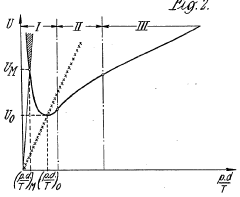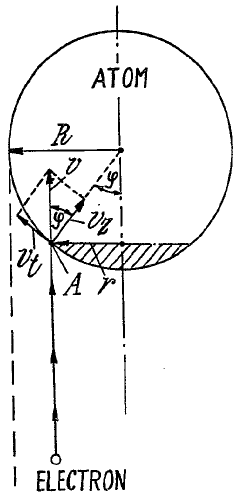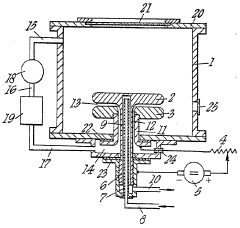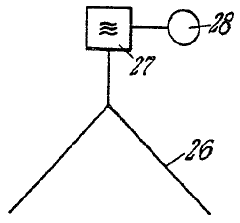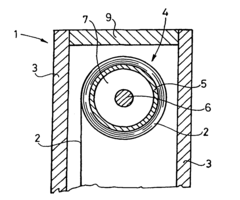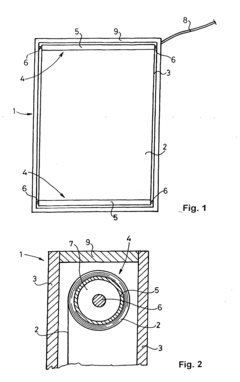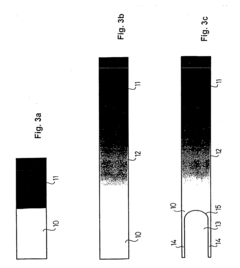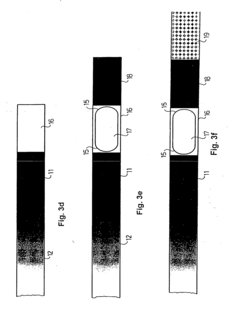How Electromagnetic Waves Advance Green Building Technologies?
JUL 11, 202510 MIN READ
Generate Your Research Report Instantly with AI Agent
Patsnap Eureka helps you evaluate technical feasibility & market potential.
EM Waves in Green Building: Background and Objectives
Electromagnetic waves have emerged as a pivotal technology in advancing green building practices, revolutionizing the way we design, construct, and operate sustainable structures. The evolution of this technology in the context of green buildings has been driven by the growing need for energy-efficient and environmentally friendly solutions in the construction industry. As global concerns about climate change and resource depletion intensify, the integration of electromagnetic wave technologies in buildings has become increasingly crucial.
The journey of electromagnetic waves in green building technologies can be traced back to the early 2000s when researchers began exploring their potential applications in energy management and environmental monitoring. Initially, the focus was primarily on utilizing radio frequency identification (RFID) for tracking building materials and improving construction logistics. However, as the technology matured, its applications expanded to encompass a wide range of sustainable building practices.
One of the key objectives in leveraging electromagnetic waves for green buildings is to optimize energy consumption. This includes the development of smart lighting systems that use occupancy sensors and daylight harvesting techniques to adjust artificial lighting levels, significantly reducing electricity usage. Additionally, electromagnetic wave-based technologies are being employed to create intelligent heating, ventilation, and air conditioning (HVAC) systems that can adapt to occupancy patterns and environmental conditions, further enhancing energy efficiency.
Another critical goal is to improve indoor environmental quality through the use of electromagnetic wave-based sensors and monitoring systems. These technologies enable real-time tracking of air quality, temperature, humidity, and other parameters, ensuring optimal comfort for occupants while minimizing energy waste. Furthermore, electromagnetic waves play a crucial role in the development of advanced building materials, such as electrochromic windows that can dynamically control solar heat gain and glare.
The integration of electromagnetic wave technologies in green buildings also aims to facilitate the adoption of renewable energy sources. For instance, wireless power transfer systems based on electromagnetic principles are being explored to enhance the efficiency of solar panel installations and reduce the need for complex wiring. Moreover, electromagnetic wave-based communication protocols are enabling the seamless integration of various building systems, creating a cohesive and intelligent ecosystem that optimizes resource utilization.
As we look towards the future, the objectives for electromagnetic wave technologies in green buildings continue to evolve. Researchers and industry professionals are working towards developing more sophisticated and miniaturized sensors, improving wireless communication protocols for building automation, and exploring novel applications such as energy harvesting from ambient electromagnetic fields. The ultimate goal is to create buildings that are not only energy-efficient and environmentally friendly but also adaptive, resilient, and capable of interacting with their surroundings in intelligent ways.
The journey of electromagnetic waves in green building technologies can be traced back to the early 2000s when researchers began exploring their potential applications in energy management and environmental monitoring. Initially, the focus was primarily on utilizing radio frequency identification (RFID) for tracking building materials and improving construction logistics. However, as the technology matured, its applications expanded to encompass a wide range of sustainable building practices.
One of the key objectives in leveraging electromagnetic waves for green buildings is to optimize energy consumption. This includes the development of smart lighting systems that use occupancy sensors and daylight harvesting techniques to adjust artificial lighting levels, significantly reducing electricity usage. Additionally, electromagnetic wave-based technologies are being employed to create intelligent heating, ventilation, and air conditioning (HVAC) systems that can adapt to occupancy patterns and environmental conditions, further enhancing energy efficiency.
Another critical goal is to improve indoor environmental quality through the use of electromagnetic wave-based sensors and monitoring systems. These technologies enable real-time tracking of air quality, temperature, humidity, and other parameters, ensuring optimal comfort for occupants while minimizing energy waste. Furthermore, electromagnetic waves play a crucial role in the development of advanced building materials, such as electrochromic windows that can dynamically control solar heat gain and glare.
The integration of electromagnetic wave technologies in green buildings also aims to facilitate the adoption of renewable energy sources. For instance, wireless power transfer systems based on electromagnetic principles are being explored to enhance the efficiency of solar panel installations and reduce the need for complex wiring. Moreover, electromagnetic wave-based communication protocols are enabling the seamless integration of various building systems, creating a cohesive and intelligent ecosystem that optimizes resource utilization.
As we look towards the future, the objectives for electromagnetic wave technologies in green buildings continue to evolve. Researchers and industry professionals are working towards developing more sophisticated and miniaturized sensors, improving wireless communication protocols for building automation, and exploring novel applications such as energy harvesting from ambient electromagnetic fields. The ultimate goal is to create buildings that are not only energy-efficient and environmentally friendly but also adaptive, resilient, and capable of interacting with their surroundings in intelligent ways.
Market Demand for Sustainable Construction Solutions
The demand for sustainable construction solutions has been steadily increasing in recent years, driven by growing environmental concerns, stringent regulations, and the need for energy-efficient buildings. Electromagnetic wave technologies are emerging as a crucial component in advancing green building practices, offering innovative solutions to reduce energy consumption, improve indoor environmental quality, and enhance overall building performance.
One of the primary market drivers for sustainable construction solutions is the global push for energy efficiency. Buildings account for a significant portion of global energy consumption and greenhouse gas emissions. As governments and organizations worldwide set ambitious targets for carbon reduction, the construction industry is under pressure to adopt more sustainable practices. Electromagnetic wave technologies, such as smart sensors and wireless communication systems, enable real-time monitoring and optimization of building energy usage, contributing to substantial energy savings and reduced carbon footprints.
The market for green building materials and technologies is experiencing rapid growth. According to industry reports, the global green building materials market is projected to reach substantial values in the coming years, with a compound annual growth rate (CAGR) exceeding previous forecasts. This growth is partly attributed to the integration of electromagnetic wave technologies in building systems, which enhance the performance of sustainable materials and enable more efficient resource management.
Indoor environmental quality is another critical factor driving the demand for sustainable construction solutions. Occupant health, comfort, and productivity are increasingly recognized as essential aspects of building design. Electromagnetic wave technologies play a vital role in this area by enabling advanced lighting control systems, air quality monitoring, and thermal comfort optimization. These solutions not only improve occupant well-being but also contribute to energy savings and reduced operational costs.
The construction industry is also witnessing a growing interest in smart building technologies. The integration of Internet of Things (IoT) devices, powered by electromagnetic wave communication, allows for seamless connectivity and data exchange within buildings. This trend is driving the demand for solutions that can monitor, control, and optimize various building systems, from HVAC to security, leading to improved energy efficiency and reduced maintenance costs.
Furthermore, the market for sustainable construction solutions is being shaped by evolving building codes and regulations. Many countries and regions are implementing stricter energy efficiency standards and sustainability requirements for new constructions and renovations. Electromagnetic wave technologies offer innovative ways to meet these regulations, providing building owners and operators with tools to comply with energy performance standards and achieve green building certifications.
As the construction industry continues to embrace digitalization, the demand for electromagnetic wave-based solutions in sustainable building practices is expected to grow further. These technologies not only address current market needs for energy efficiency and environmental sustainability but also pave the way for future innovations in smart, connected, and green buildings.
One of the primary market drivers for sustainable construction solutions is the global push for energy efficiency. Buildings account for a significant portion of global energy consumption and greenhouse gas emissions. As governments and organizations worldwide set ambitious targets for carbon reduction, the construction industry is under pressure to adopt more sustainable practices. Electromagnetic wave technologies, such as smart sensors and wireless communication systems, enable real-time monitoring and optimization of building energy usage, contributing to substantial energy savings and reduced carbon footprints.
The market for green building materials and technologies is experiencing rapid growth. According to industry reports, the global green building materials market is projected to reach substantial values in the coming years, with a compound annual growth rate (CAGR) exceeding previous forecasts. This growth is partly attributed to the integration of electromagnetic wave technologies in building systems, which enhance the performance of sustainable materials and enable more efficient resource management.
Indoor environmental quality is another critical factor driving the demand for sustainable construction solutions. Occupant health, comfort, and productivity are increasingly recognized as essential aspects of building design. Electromagnetic wave technologies play a vital role in this area by enabling advanced lighting control systems, air quality monitoring, and thermal comfort optimization. These solutions not only improve occupant well-being but also contribute to energy savings and reduced operational costs.
The construction industry is also witnessing a growing interest in smart building technologies. The integration of Internet of Things (IoT) devices, powered by electromagnetic wave communication, allows for seamless connectivity and data exchange within buildings. This trend is driving the demand for solutions that can monitor, control, and optimize various building systems, from HVAC to security, leading to improved energy efficiency and reduced maintenance costs.
Furthermore, the market for sustainable construction solutions is being shaped by evolving building codes and regulations. Many countries and regions are implementing stricter energy efficiency standards and sustainability requirements for new constructions and renovations. Electromagnetic wave technologies offer innovative ways to meet these regulations, providing building owners and operators with tools to comply with energy performance standards and achieve green building certifications.
As the construction industry continues to embrace digitalization, the demand for electromagnetic wave-based solutions in sustainable building practices is expected to grow further. These technologies not only address current market needs for energy efficiency and environmental sustainability but also pave the way for future innovations in smart, connected, and green buildings.
Current EM Wave Applications in Green Buildings
Electromagnetic (EM) waves are currently being utilized in various innovative ways to enhance the sustainability and efficiency of green buildings. One of the most prominent applications is in smart lighting systems. These systems employ EM waves in the form of visible light and radio frequencies to create adaptive illumination environments. Sensors detect occupancy and ambient light levels, allowing for automatic adjustment of artificial lighting intensity and color temperature. This not only reduces energy consumption but also improves occupant comfort and productivity.
Another significant application is in the realm of wireless sensor networks for building management. These networks use radio frequency EM waves to transmit data from various sensors throughout the building. These sensors monitor parameters such as temperature, humidity, air quality, and energy consumption. The collected data is then used to optimize HVAC systems, resulting in improved energy efficiency and indoor environmental quality.
EM waves also play a crucial role in energy harvesting technologies for green buildings. Photovoltaic systems, which convert solar radiation (a form of EM waves) into electricity, are increasingly being integrated into building facades and roofs. Additionally, radio frequency energy harvesting systems are being developed to capture ambient EM waves from Wi-Fi and cellular networks, converting them into usable electricity for low-power devices within the building.
In the field of thermal management, EM wave applications are making significant strides. Infrared imaging technologies are being used to detect heat loss and identify areas of poor insulation in buildings. This allows for targeted improvements in thermal efficiency. Moreover, advanced window technologies utilizing EM wave principles, such as electrochromic and thermochromic glazing, can dynamically control solar heat gain and daylighting, reducing the load on HVAC and lighting systems.
Wireless power transfer, based on EM wave principles, is emerging as a promising technology for green buildings. This technology enables the charging of mobile devices and powering of low-energy appliances without the need for extensive wiring, potentially reducing material usage and improving space flexibility. Furthermore, EM waves are being harnessed in building-integrated communication systems, facilitating the implementation of Internet of Things (IoT) devices that enhance overall building intelligence and energy management.
Lastly, EM wave applications are advancing the field of non-destructive testing in green buildings. Ground-penetrating radar and microwave moisture detection systems use EM waves to assess the structural integrity of buildings and detect moisture issues without causing damage. This proactive approach to building maintenance helps prevent energy waste and extends the lifespan of green buildings, contributing to their long-term sustainability.
Another significant application is in the realm of wireless sensor networks for building management. These networks use radio frequency EM waves to transmit data from various sensors throughout the building. These sensors monitor parameters such as temperature, humidity, air quality, and energy consumption. The collected data is then used to optimize HVAC systems, resulting in improved energy efficiency and indoor environmental quality.
EM waves also play a crucial role in energy harvesting technologies for green buildings. Photovoltaic systems, which convert solar radiation (a form of EM waves) into electricity, are increasingly being integrated into building facades and roofs. Additionally, radio frequency energy harvesting systems are being developed to capture ambient EM waves from Wi-Fi and cellular networks, converting them into usable electricity for low-power devices within the building.
In the field of thermal management, EM wave applications are making significant strides. Infrared imaging technologies are being used to detect heat loss and identify areas of poor insulation in buildings. This allows for targeted improvements in thermal efficiency. Moreover, advanced window technologies utilizing EM wave principles, such as electrochromic and thermochromic glazing, can dynamically control solar heat gain and daylighting, reducing the load on HVAC and lighting systems.
Wireless power transfer, based on EM wave principles, is emerging as a promising technology for green buildings. This technology enables the charging of mobile devices and powering of low-energy appliances without the need for extensive wiring, potentially reducing material usage and improving space flexibility. Furthermore, EM waves are being harnessed in building-integrated communication systems, facilitating the implementation of Internet of Things (IoT) devices that enhance overall building intelligence and energy management.
Lastly, EM wave applications are advancing the field of non-destructive testing in green buildings. Ground-penetrating radar and microwave moisture detection systems use EM waves to assess the structural integrity of buildings and detect moisture issues without causing damage. This proactive approach to building maintenance helps prevent energy waste and extends the lifespan of green buildings, contributing to their long-term sustainability.
Existing EM Wave Solutions for Energy Efficiency
01 Electromagnetic wave detection and measurement
Various devices and methods for detecting and measuring electromagnetic waves are described. These include sensors, antennas, and other specialized equipment designed to capture and analyze electromagnetic signals across different frequencies and intensities.- Electromagnetic wave detection and measurement: Various devices and methods for detecting and measuring electromagnetic waves are described. These include sensors, antennas, and specialized equipment designed to capture and analyze electromagnetic signals across different frequencies and intensities.
- Electromagnetic wave shielding and protection: Technologies for shielding and protecting against electromagnetic waves are presented. These involve materials and structures designed to block or absorb electromagnetic radiation, protecting sensitive equipment or living organisms from potential harmful effects.
- Electromagnetic wave communication systems: Advancements in communication systems utilizing electromagnetic waves are discussed. These include improvements in wireless transmission, reception, and processing of electromagnetic signals for various applications such as mobile networks and satellite communications.
- Electromagnetic wave energy harvesting: Innovative methods for harvesting energy from electromagnetic waves are explored. These technologies aim to capture and convert ambient electromagnetic radiation into usable electrical energy for powering devices or supplementing existing power sources.
- Electromagnetic wave applications in medical field: The use of electromagnetic waves in medical applications is examined. This includes diagnostic imaging techniques, therapeutic treatments, and monitoring systems that leverage various frequencies of electromagnetic radiation for healthcare purposes.
02 Electromagnetic wave shielding and protection
Technologies for shielding and protecting against electromagnetic waves are presented. These involve materials and structures designed to block or absorb electromagnetic radiation, protecting sensitive equipment or living organisms from potential harmful effects.Expand Specific Solutions03 Electromagnetic wave communication systems
Advancements in communication systems utilizing electromagnetic waves are discussed. These include improvements in wireless communication technologies, signal processing techniques, and network architectures to enhance data transmission and reception.Expand Specific Solutions04 Electromagnetic wave energy harvesting
Innovations in harnessing energy from electromagnetic waves are explored. These technologies aim to capture and convert ambient electromagnetic radiation into usable electrical energy, potentially providing power for various applications.Expand Specific Solutions05 Electromagnetic wave applications in medical field
The use of electromagnetic waves in medical applications is presented. This includes diagnostic imaging techniques, therapeutic treatments, and monitoring systems that leverage electromagnetic properties for healthcare purposes.Expand Specific Solutions
Key Players in Green Building EM Wave Industry
The electromagnetic wave technology in green building is in a growth phase, with increasing market size and evolving applications. The industry is characterized by a mix of established players and innovative startups, reflecting a moderate level of technological maturity. Key companies like China Building Materials Academy Co. Ltd., Sika Technology AG, and View Operating Corp. are driving advancements in smart windows, energy-efficient materials, and building automation. Academic institutions such as MIT, Zhejiang University, and Tongji University are contributing to research and development. The market is expanding as more construction firms and property developers adopt these technologies to meet sustainability goals and energy efficiency standards.
Massachusetts Institute of Technology
Technical Solution: MIT has developed innovative electromagnetic wave-based technologies for green buildings. Their research includes the use of metamaterials to create "smart" windows that can selectively filter different wavelengths of light, allowing for better temperature control and energy efficiency[1]. They have also explored the use of wireless power transfer systems using electromagnetic waves to power sensors and devices within buildings, reducing the need for wiring and batteries[2]. Additionally, MIT researchers have developed electromagnetic shielding materials that can block unwanted electromagnetic interference while allowing beneficial signals to pass through, improving the performance of wireless systems in buildings[3].
Strengths: Cutting-edge research in metamaterials and wireless power transfer. Weaknesses: Some technologies may be in early stages and not yet commercially viable.
Heliotrope Technologies, Inc.
Technical Solution: Heliotrope Technologies has developed an advanced electrochromic glass technology that utilizes electromagnetic waves to control the tinting of windows. Their smart glass can dynamically adjust its opacity and heat transmission properties in response to electrical signals, allowing for optimal light and heat management in buildings[4]. The technology employs a proprietary nanocrystal-based coating that can switch between clear and tinted states rapidly, offering superior performance compared to traditional electrochromic solutions[5]. This innovation contributes to significant energy savings in heating, cooling, and lighting costs for green buildings.
Strengths: Highly efficient and fast-switching smart glass technology. Weaknesses: May have higher initial costs compared to traditional windows.
Innovative EM Wave Technologies for Sustainability
Process and device for the generation of electromagnetic waves
PatentInactiveGB977559A
Innovation
- A method involving a gas discharge in a high-density gas environment with controlled electric fields, where the electric field strength is sufficient to ionize atoms without exciting them, preventing energy conversion into light radiation and optimizing the generation of electromagnetic waves in the desired frequency range.
Device for reflecting electromagnetic waves, particularly light and heat radiation to a regulable extent, and method for the metalization of a film with a density varying with longitudinal position according to a given function
PatentInactiveUS20050287295A1
Innovation
- A device comprising a metallized film between two transparent protective plates with varying metal density along its length, driven by motorized rollers, creating an airtight space for improved heat insulation and automated light control, with integrated sensors and solar-powered control units for efficient operation.
Environmental Impact Assessment of EM Technologies
The environmental impact assessment of electromagnetic (EM) technologies in green building applications reveals both positive and negative effects on the ecosystem and human health. On the positive side, EM technologies contribute significantly to energy efficiency and resource conservation in buildings. Smart energy management systems utilizing EM sensors and wireless communication networks optimize power consumption, reducing overall energy demand and associated carbon emissions. These systems enable real-time monitoring and adjustment of heating, cooling, and lighting, leading to substantial reductions in energy waste.
Furthermore, EM-based building automation systems enhance occupant comfort while minimizing environmental impact. Sensors detecting occupancy and ambient conditions allow for precise control of HVAC systems, ensuring optimal temperature and air quality without unnecessary energy expenditure. This not only improves the building's ecological footprint but also promotes a healthier indoor environment for occupants.
However, the widespread implementation of EM technologies in buildings also raises concerns about potential negative environmental impacts. The proliferation of wireless devices and networks increases electromagnetic radiation in urban environments. While current research suggests that low-level EM radiation from these devices is within safe limits, long-term effects on human health and ecosystems remain a subject of ongoing study.
Additionally, the production and disposal of EM devices and components pose environmental challenges. The manufacturing process of sensors, transmitters, and other electronic components often involves the use of rare earth elements and toxic materials. Improper disposal of these devices can lead to electronic waste accumulation, potentially contaminating soil and water sources.
To mitigate these negative impacts, green building initiatives are increasingly focusing on sustainable EM technology lifecycles. This includes the development of eco-friendly manufacturing processes, the use of recyclable materials in device construction, and the implementation of effective e-waste management programs. Moreover, efforts are being made to optimize EM system designs to reduce power consumption and minimize unnecessary radiation emissions.
In conclusion, while EM technologies offer significant benefits for green building performance and energy efficiency, their environmental impact must be carefully managed. Balancing the advantages of improved building performance against potential ecological risks requires ongoing research, responsible implementation, and a commitment to sustainable technology practices throughout the lifecycle of EM systems in green buildings.
Furthermore, EM-based building automation systems enhance occupant comfort while minimizing environmental impact. Sensors detecting occupancy and ambient conditions allow for precise control of HVAC systems, ensuring optimal temperature and air quality without unnecessary energy expenditure. This not only improves the building's ecological footprint but also promotes a healthier indoor environment for occupants.
However, the widespread implementation of EM technologies in buildings also raises concerns about potential negative environmental impacts. The proliferation of wireless devices and networks increases electromagnetic radiation in urban environments. While current research suggests that low-level EM radiation from these devices is within safe limits, long-term effects on human health and ecosystems remain a subject of ongoing study.
Additionally, the production and disposal of EM devices and components pose environmental challenges. The manufacturing process of sensors, transmitters, and other electronic components often involves the use of rare earth elements and toxic materials. Improper disposal of these devices can lead to electronic waste accumulation, potentially contaminating soil and water sources.
To mitigate these negative impacts, green building initiatives are increasingly focusing on sustainable EM technology lifecycles. This includes the development of eco-friendly manufacturing processes, the use of recyclable materials in device construction, and the implementation of effective e-waste management programs. Moreover, efforts are being made to optimize EM system designs to reduce power consumption and minimize unnecessary radiation emissions.
In conclusion, while EM technologies offer significant benefits for green building performance and energy efficiency, their environmental impact must be carefully managed. Balancing the advantages of improved building performance against potential ecological risks requires ongoing research, responsible implementation, and a commitment to sustainable technology practices throughout the lifecycle of EM systems in green buildings.
Regulatory Framework for EM Use in Green Buildings
The regulatory framework for electromagnetic (EM) wave use in green buildings is a complex and evolving landscape that plays a crucial role in advancing sustainable construction practices. As governments and international organizations increasingly recognize the potential of EM technologies in enhancing building energy efficiency and environmental performance, they are developing comprehensive guidelines and standards to ensure safe and effective implementation.
At the forefront of this regulatory framework are energy efficiency standards that incorporate EM-based solutions. Many countries have adopted building codes that mandate the use of smart energy management systems, which often rely on EM technologies for data transmission and control. These regulations typically specify minimum performance requirements for wireless sensor networks, smart meters, and automated building management systems, all of which utilize EM waves for communication and operation.
Safety regulations form another critical component of the framework, addressing concerns about potential health impacts of EM radiation in buildings. Regulatory bodies have established exposure limits for various frequencies used in green building technologies, ensuring that occupants are not subjected to harmful levels of electromagnetic fields. These guidelines often differentiate between general public exposure and occupational exposure, with more stringent limits applied to areas accessible to the general public.
Electromagnetic compatibility (EMC) regulations are also integral to the framework, as they ensure that EM-based green building technologies do not interfere with other electronic systems or critical infrastructure. These regulations typically require manufacturers to demonstrate that their products meet specific EMC standards before they can be installed in buildings. This includes testing for both emissions and immunity to electromagnetic interference.
Data privacy and security regulations have become increasingly important as smart building technologies collect and transmit large amounts of data using EM waves. Regulatory frameworks now often include provisions for data protection, mandating encryption standards for wireless communications and specifying requirements for secure data storage and transmission within green building systems.
To promote innovation while maintaining safety and performance standards, many regulatory bodies have adopted a technology-neutral approach. This allows for the integration of new EM-based solutions as they emerge, provided they meet established performance criteria. Some jurisdictions have also implemented fast-track approval processes for green building technologies that demonstrate significant environmental benefits, including those utilizing advanced EM applications.
International collaboration has been key in developing harmonized standards for EM use in green buildings. Organizations such as the International Electrotechnical Commission (IEC) and the Institute of Electrical and Electronics Engineers (IEEE) have been instrumental in creating global standards that facilitate the adoption of EM-based green technologies across different regions. These efforts have helped to reduce barriers to trade and accelerate the global uptake of innovative sustainable building solutions.
At the forefront of this regulatory framework are energy efficiency standards that incorporate EM-based solutions. Many countries have adopted building codes that mandate the use of smart energy management systems, which often rely on EM technologies for data transmission and control. These regulations typically specify minimum performance requirements for wireless sensor networks, smart meters, and automated building management systems, all of which utilize EM waves for communication and operation.
Safety regulations form another critical component of the framework, addressing concerns about potential health impacts of EM radiation in buildings. Regulatory bodies have established exposure limits for various frequencies used in green building technologies, ensuring that occupants are not subjected to harmful levels of electromagnetic fields. These guidelines often differentiate between general public exposure and occupational exposure, with more stringent limits applied to areas accessible to the general public.
Electromagnetic compatibility (EMC) regulations are also integral to the framework, as they ensure that EM-based green building technologies do not interfere with other electronic systems or critical infrastructure. These regulations typically require manufacturers to demonstrate that their products meet specific EMC standards before they can be installed in buildings. This includes testing for both emissions and immunity to electromagnetic interference.
Data privacy and security regulations have become increasingly important as smart building technologies collect and transmit large amounts of data using EM waves. Regulatory frameworks now often include provisions for data protection, mandating encryption standards for wireless communications and specifying requirements for secure data storage and transmission within green building systems.
To promote innovation while maintaining safety and performance standards, many regulatory bodies have adopted a technology-neutral approach. This allows for the integration of new EM-based solutions as they emerge, provided they meet established performance criteria. Some jurisdictions have also implemented fast-track approval processes for green building technologies that demonstrate significant environmental benefits, including those utilizing advanced EM applications.
International collaboration has been key in developing harmonized standards for EM use in green buildings. Organizations such as the International Electrotechnical Commission (IEC) and the Institute of Electrical and Electronics Engineers (IEEE) have been instrumental in creating global standards that facilitate the adoption of EM-based green technologies across different regions. These efforts have helped to reduce barriers to trade and accelerate the global uptake of innovative sustainable building solutions.
Unlock deeper insights with Patsnap Eureka Quick Research — get a full tech report to explore trends and direct your research. Try now!
Generate Your Research Report Instantly with AI Agent
Supercharge your innovation with Patsnap Eureka AI Agent Platform!
